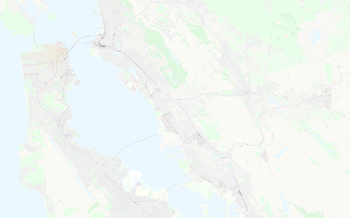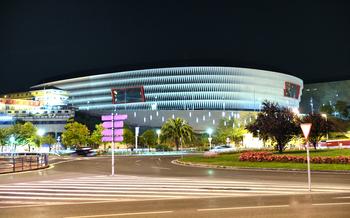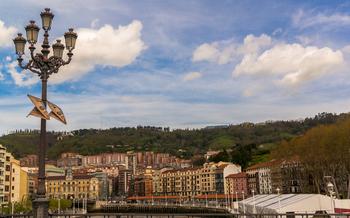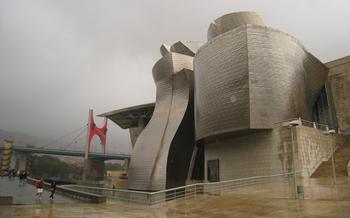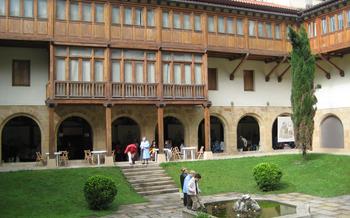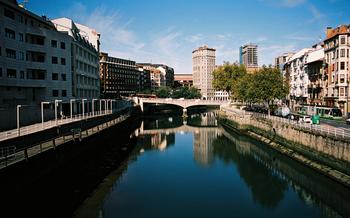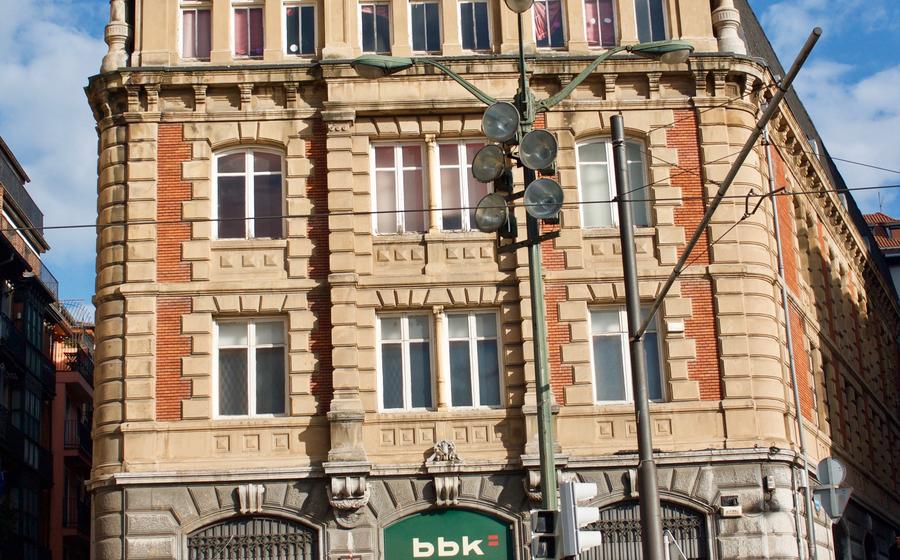
Casco Viejo (Old Town)
- Exploring the Casco Viejo: Bilbao's Historic Heart
- A Walk Through History: The Seven Streets
- Bilbao Cathedral: A Gothic Masterpiece
- Plaza Nueva: A Lively Meeting Point
- Museo Vasco: A Showcase of Basque Culture
- Mercado de la Ribera: A Culinary Adventure
- Plaza Moyua: A Green Oasis in the City
- Arriaga Theatre: A Cultural Icon
- River Walk: A Scenic Stroll Along the Nervion
- Athletic Bilbao Stadium: A Pilgrimage for Football Fans
- Bilbao Fine Arts Museum: A Treasure Trove of Art
- Insider Tip: Hidden Gems in the Casco Viejo
Exploring the Casco Viejo: Bilbao's Historic Heart
Bilbao's Casco Viejo, also known as the Old Town, is a captivating labyrinth of narrow cobblestone streets and medieval buildings that transport visitors back in time. Originally founded in the 14th century, it's the beating heart of the city, teeming with history, culture, and vibrant local life.
A stroll through the Casco Viejo is a journey through the ages, where ancient churches, grand plazas, and hidden courtyards whisper tales of Bilbao's rich past. Plan to spend at least half a day wandering its charming streets, soaking in the atmosphere, and discovering its many hidden gems. The best time to visit is in the morning or evening, when the crowds are smaller, and the sun casts a warm glow on the old stone facades.
Before embarking on your exploration, be sure to pick up a map from the tourist information office to help you navigate the maze-like streets. Comfortable walking shoes are a must, as you'll be doing a lot of pavement pounding. And don't forget your camera to capture the beauty of this historic neighborhood.
A Walk Through History: The Seven Streets
In the heart of the Casco Viejo lies the Siete Calles (Seven Streets), a captivating labyrinth of narrow, winding streets that has stood the test of time. Originally conceived in the 15th century as a safe haven for merchants and traders, the Seven Streets gradually evolved into a vibrant commercial and residential district.
The layout of the Seven Streets is a testament to its medieval origins. The narrow, winding streets were designed to deter unwanted visitors and provide a sense of security for the residents. The streets are lined with historic buildings, many of which feature intricate facades and wooden balconies that have been beautifully preserved.
Among the architectural highlights of the Seven Streets is the Plaza Nueva (New Square), a stunning square that was built in the 19th century. The square is surrounded by elegant neoclassical buildings and features a beautiful fountain in its center.
The Seven Streets is also home to several notable landmarks, including the Gothic-style Santiago Cathedral, the Baroque-style Church of San Antón, and the neoclassical City Hall. These landmarks stand as a testament to the rich cultural heritage of Bilbao and are a must-see for any visitor to the city.
Bilbao Cathedral: A Gothic Masterpiece
The grandeur of Bilbao Cathedral, an iconic landmark of the Casco Viejo, is a testament to the city's rich history and devotion to religious traditions. Constructed primarily in the Gothic architectural style, this imposing cathedral, known locally as Catedral de Santiago, has undergone various modifications and expansions over the centuries, resulting in a unique blend of architectural elements.
The origins of the cathedral can be traced back to the 14th century when it was built on the site of a former Romanesque church. While the exterior boasts a majestic Gothic facade characterized by intricate carvings, flying buttresses, and a prominent bell tower, the interior exudes an aura of serenity and spirituality.
Within the cathedral's hallowed halls, visitors are captivated by the soaring ribbed vaults, elegant stained-glass windows that depict biblical scenes, and beautifully crafted altarpieces. The main altarpiece, a masterpiece of Gothic art, is a testament to the skill and devotion of its creators, portraying scenes from the life of Christ and the Virgin Mary.
Bilbao Cathedral also houses several significant religious artifacts, including a 15th-century wooden statue of the Virgin Mary, known as the Virgen de Begoña, which is deeply revered by the local Basque population. The cathedral's cloister, a tranquil oasis within the bustling city, features a serene garden, Gothic arches, and intricate carvings that evoke a sense of medieval charm.
Visiting Bilbao Cathedral is a must for anyone seeking to delve into the city's religious and cultural heritage. Its awe-inspiring architecture, sacred artworks, and historical significance make it a spiritual and artistic treasure that should not be missed.
Plaza Nueva: A Lively Meeting Point
In the heart of Bilbao's Casco Viejo, Plaza Nueva stands as a testament to the city's rich past and vibrant present. Constructed in the 19th century on the site of a former bullring, the plaza exudes an aura of history and charm.
Architectural Style The plaza's architectural style is a blend of Neoclassical and Basque elements. The surrounding buildings boast elegant facades adorned with intricate carvings and wrought-iron balconies. The centerpiece of the plaza is a majestic fountain topped by a bronze statue of a woman representing Bilbao.
Historical Significance Plaza Nueva holds immense historical significance for Bilbao. It was once the city's main square and marketplace, where merchants and traders gathered to conduct business. The plaza also served as a venue for public events and celebrations. Today, it remains a popular gathering spot for locals and tourists alike, who come to soak in the atmosphere and enjoy the lively ambiance.
Notable Features One of the most striking features of Plaza Nueva is its arcaded walkways. These graceful arches provide shelter from the sun and rain, creating a pleasant environment for strolls and people-watching. The plaza is also home to several notable landmarks, including the Church of San Nicolás and the Arriaga Theatre, which contribute to its rich cultural heritage.
Surrounding Attractions In addition to its own attractions, Plaza Nueva is surrounded by a wealth of other historic sites and cultural venues. Visitors can explore the nearby Bilbao Cathedral, the Museo Vasco, and the Mercado de la Ribera, all within a short walk. The plaza serves as an excellent starting point for discovering the many treasures of Bilbao's Old Town.
Museo Vasco: A Showcase of Basque Culture
Delving into the Basque Heritage: Located in the heart of the Casco Viejo, the Museo Vasco is a testament to the rich cultural heritage of the Basque Country. Founded in 1921, this museum offers a comprehensive exploration of Basque history, traditions, and way of life.
Diverse Exhibits and Collections: As you step inside the museum, you'll be greeted by a diverse array of exhibits showcasing Basque culture. From traditional costumes and tools to ancient artifacts and contemporary art, the museum provides a comprehensive overview of the region's past and present.
Historical Context: The museum's exhibits are thoughtfully curated to provide visitors with historical context. You'll learn about the Basque language, the region's unique political and social structures, and the significant contributions Basques have made to fields like maritime exploration and gastronomy.
Interactive Displays: To enhance the visitor experience, the museum incorporates interactive displays that bring the exhibits to life. Touchscreens, multimedia presentations, and hands-on activities allow visitors to engage with the material in a fun and educational way.
Practical Information: The Museo Vasco is open from Tuesday to Sunday, with varying hours depending on the season. Admission fees are reasonable, and guided tours are available in English and Spanish. The museum also offers a range of educational programs and workshops throughout the year.
Mercado de la Ribera: A Culinary Adventure
In the heart of the Casco Viejo, the Mercado de la Ribera is a bustling hub of culinary activity. Originally built in the 1920s, this market hall was once the main fish market of Bilbao. Today, it has transformed into a vibrant and modern space that showcases the diverse flavors of Basque cuisine.
Stepping into the market, visitors are greeted by an array of stalls displaying fresh seafood, meats, cheeses, produce, and artisanal products. The lively atmosphere and the chatter of vendors create a vibrant ambiance that is sure to entice any foodie.
One of the highlights of the Mercado de la Ribera is the variety of pintxos (Basque tapas) stalls. These small plates, often served on slices of bread or as skewers, offer a delightful way to sample the region's traditional cuisine. From classic pintxos like gildas (anchovies, olives, and peppers) to more innovative creations, there's something to satisfy every palate.
For those looking for a more substantial meal, there are several sit-down restaurants within the market. Here, visitors can indulge in traditional Basque dishes such as bacalao al pil pil (cod in a pil pil sauce), txipirones en su tinta (squid in its ink), or a hearty cocido (stew).
Whether you're a food enthusiast, a casual diner, or simply looking for a taste of local life, the Mercado de la Ribera is a must-visit destination in Bilbao. So come hungry and prepare to embark on a culinary adventure that will leave you wanting more.
Plaza Moyua: A Green Oasis in the City
Plaza Moyúa stands as the heart of Bilbao, a vibrant intersection where nature and urban life harmoniously blend. Created in 1896, this leafy haven offers respite from the city's energetic pulse, inviting locals and visitors alike to relax, socialize, and admire its verdant splendor.
The plaza's centerpiece is its picturesque pond, a tranquil oasis surrounded by a lush green border. Here, ducks and swans glide gracefully across the water, adding a touch of serenity to the bustling city backdrop. Ornate lampposts illuminate the pond at night, casting a warm glow over the tranquil waters.
While Plaza Moyúa provides a tranquil retreat, it also serves as a vibrant hub for cultural and social events. Throughout the year, the plaza hosts a variety of concerts, exhibitions, and festivals, transforming into a stage for artistic expression and community gatherings.
Surrounding the plaza, several notable buildings contribute to its architectural charm. The iconic Moyúa Palace, with its elegant facade and intricate carvings, reflects the grandeur of Bilbao's past. The Carlton Hotel, with its distinctive Belle Époque style, adds a touch of Parisian elegance to the cityscape.
To fully experience the essence of Plaza Moyúa, take a leisurely stroll along its perimeter, admiring the surrounding buildings and the vibrant energy of the city. Whether seeking a tranquil escape or immersing yourself in the cultural pulse of Bilbao, Plaza Moyúa offers a unique and memorable experience.
Practical Information:
-
Location: Plaza Moyúa is situated in the heart of Bilbao, easily accessible by foot or public transportation.
-
Accessibility: The plaza is wheelchair accessible, with ramps and elevators providing easy access to all areas.
-
Opening Hours: Plaza Moyúa is open 24 hours a day, allowing visitors to enjoy its serene atmosphere at any time.
-
Nearby Attractions: The plaza is surrounded by several notable attractions, including the Moyúa Palace, the Carlton Hotel, the Guggenheim Museum, and the Arriaga Theatre, making it an ideal starting point for exploring the city.
Arriaga Theatre: A Cultural Icon
The Arriaga Theatre, named after90, captivating audiences with its opulent facade and enchanting performances.
The Arriaga Theatre is renowned for its exquisite architectural details, showcasing a blend of Baroque and Renaissance influences. Its grand entrance, adorned with intricate carvings and sculptures, sets the stage for an unforgettable theatrical experience. The theatre's interior is equally impressive, featuring plush red velvet seats, gilded balconies, and an ornate ceiling that transports visitors back in time.
The Arriaga Theatre has played a pivotal role in Bilbao's cultural scene for over a century. It has hosted a wide range of performances, including opera, ballet, and plays, featuring both local and international artists. Some of the most renowned names in the performing arts have graced the Arriaga Theatre's stage, leaving a lasting legacy of artistic excellence.
Whether you are a theatre enthusiast or simply appreciate architectural grandeur, the Arriaga Theatre is a must-visit destination in Bilbao. Take advantage of the guided tours to delve into the theatre's fascinating history, admire its intricate details, and experience the magic that unfolds on its stage.
River Walk: A Scenic Stroll Along the Nervion
The River Walk is a picturesque promenade that follows the meandering Nervion River, offering breathtaking views of the city's iconic landmarks and a tranquil retreat from the urban hustle. Stretching for approximately 6 kilometers, the walk is a delightful way to explore Bilbao's riverside charms, taking you past verdant parks, charming bridges, and architectural wonders.
Allow yourself at least two hours to fully enjoy the walk, taking in the sights and soaking up the vibrant atmosphere. The best time to visit is during the spring or autumn, when the weather is pleasant and the city is adorned with a tapestry of colors. For a truly memorable experience, consider embarking on the walk at dusk, when the city's lights twinkle against the darkening sky, creating a magical ambiance.
Practical information:
- Starting point: Ribera Market.
- End point: Guggenheim Museum.
- Highlights: Zubizuri Bridge, Pedro Arrupe Footbridge, Euskalduna Conference Center and Concert Hall.
- Accessibility: Wheelchair accessible.
- Tips: Comfortable shoes, camera, water bottle.
Athletic Bilbao Stadium: A Pilgrimage for Football Fans
Athletic Club de Bilbao, affectionately known as Los Leones (The Lions), is one of the most passionate and deeply rooted football clubs in Europe. Their iconic stadium, San Mamés, is a true pilgrimage site for football enthusiasts, steeped in history and pulsating with an electrifying atmosphere on match days.
Completed in 2013, the new San Mamés replaced the old stadium of the same name, which had stood proudly for over a century. The new stadium boasts a capacity of over 53,000 seats, a retractable roof, and state-of-the-art facilities, making it one of the finest football venues in Spain.
A tour of the stadium is a must for any football fan. Visitors can explore the players' tunnel, dressing rooms, press room, and VIP areas, and learn about the club's rich history and impressive trophy cabinet. On match days, San Mamés transforms into a cauldron of noise and passion. The atmosphere is electric, with the roar of the crowd reverberating through the stands. Watching an Athletic Bilbao match here is an unforgettable experience, a true celebration of the beautiful game.
Practical Information:
- Location: San Mamés Barria, 1, 48013 Bilbao, Bizkaia, Spain
- Stadium Tours: Available daily, except on match days and during special events.
- Tickets: Can be purchased online or at the stadium ticket office.
- Match Tickets: Sold through the club's website or authorized ticket vendors.
Bilbao Fine Arts Museum: A Treasure Trove of Art
History and Transformation The Bilbao Fine Arts Museum, nestled in the heart of the city's cultural district, stands as a testament to the rich artistic heritage of the Basque Country. Its origins can be traced back to the early 19th century when a group of art enthusiasts and collectors envisioned a museum that would showcase the works of local and international masters. Over the years, the museum has undergone several expansions and renovations, evolving into a renowned institution that attracts art aficionados from around the world.
Notable Collections The Bilbao Fine Arts Museum boasts a diverse collection that spans various artistic periods and styles. From medieval religious art to contemporary masterpieces, the museum offers a journey through the history of art. Visitors can admire works by renowned Spanish artists such as El Greco, Goya, and Dalí, as well as international masters like Rubens, Van Dyck, and Monet. The collection also includes an impressive array of Basque art, highlighting the unique artistic traditions of the region.
Highlights of the Permanent Exhibition Among the highlights of the permanent exhibition are El Greco's "The Agony in the Garden," a poignant depiction of Christ's suffering, and Goya's "The Third of May 1808," a powerful commentary on the Spanish War of Independence. Visitors can also marvel at the delicate brushstrokes of Rubens' "The Entombment" and the vibrant colors of Monet's "Water Lilies." The museum's Basque art collection features works by renowned artists such as Ignacio Zuloaga and José María Sert, offering insights into the region's cultural identity.
Practical Information The Bilbao Fine Arts Museum is open to the public from Tuesday to Sunday, with extended hours on Fridays. Admission fees vary depending on the type of ticket and any special exhibitions. The museum offers guided tours in multiple languages, allowing visitors to delve deeper into the stories behind the artworks. It's recommended to set aside at least two hours to fully appreciate the museum's vast collection.
Insider Tip: Hidden Gems in the Casco Viejo
Beyond the main attractions, the Casco Viejo hides a treasure trove of hidden gems waiting to be discovered. Wander away from the bustling streets to uncover charming alleys, secret courtyards, and unique shops that showcase the city's vibrant culture.
For a culinary adventure, seek out the traditional Basque pintxos bars tucked away in the narrow streets. Indulge in a variety of small plates, each bursting with flavor and accompanied by a glass of local wine or a refreshing zurito (small beer).
Art enthusiasts can explore the many contemporary galleries showcasing local and international artists. From avant-garde installations to thought-provoking paintings, these spaces provide a glimpse into Bilbao's thriving art scene.
If you're a book lover, don't miss the opportunity to visit one of the many independent bookstores nestled in the Casco Viejo. Browse through shelves filled with literary treasures, from classic novels to contemporary works, and engage in stimulating conversations with knowledgeable booksellers.
Throughout the year, the Casco Viejo comes alive with seasonal events and festivals. From lively street markets showcasing local crafts and produce to traditional Basque music performances, these events offer a chance to immerse yourself in the city's rich cultural heritage.

